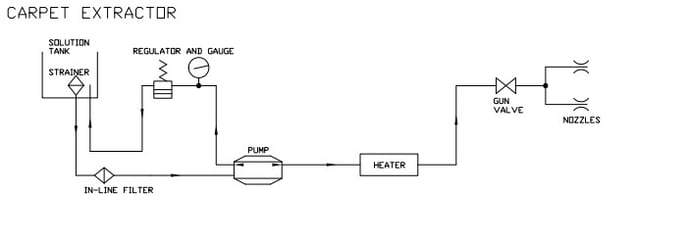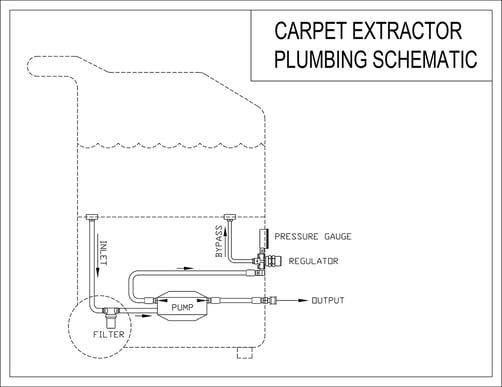Find the basic outline of a carpet extractor, common issues, and best practices for the system.
 Shown above is a basic carpet extractor systems. In the diagram you can see the pump pulls water from a solution tank through a series of filters and sends the water out to the gun and nozzle. A second outlet is used to regulate and check pressure while by-passing the excess fluid back to the solution tank. Here are a few things to take note of, avoid, and help to make your system the best it can be.
Shown above is a basic carpet extractor systems. In the diagram you can see the pump pulls water from a solution tank through a series of filters and sends the water out to the gun and nozzle. A second outlet is used to regulate and check pressure while by-passing the excess fluid back to the solution tank. Here are a few things to take note of, avoid, and help to make your system the best it can be.
First off, there needs to be enough water coming into the pump. Pumptec typically uses its' 207V, 217V, and 112V pumps in carpet extractors and would recommended feeding the pump using 1/2" S-hose. It keeps great shape and allows enough water to avoid starving the pump which leads to cavitation. These hoses easily connect with the needed strainers and filters between tank and pump. In some instances, it would be appropriate to pressure-feed the system using city water sources.
Once the fluid leaves the pump, it is imperative to use a dampening hose. At Pumptec, 3/8" pulse hose is widely used. Because of the high operating pressure and the nature of our plunger pumps, the outlet hose type is extremely important to functionality. Be sure to always double check that your inlet and outlet hoses do not get pinched or damaged so as not to overpressure or run dry. Do not run your by-pass line from the regulator directly back to the pump as this could contribute to cavitation and overheating. Run it back to the solution tank as shown in the diagram above. Over-pressuring can also result from the incorrect regulator pressure limit. Pay attention to your gauge, so you do not over-amp your motor or over-pressurize your pump.
For carpet extractors, the optimal combination of PSI and GPM for cleaning is a ratio of 1 GPM for every 300-400 PSI. This combination maintains sufficient droplet size for cleaning force and distance. If pressure increases, and flow does not, then the water droplet size reduces and has less impact force, requiring closer cleaning distances and increased risk of surface damage. Some liquids may require a flush between operations or before storing. For pumping liquids other than water, contact your supplier.

To reiterate, avoid starving or running the pump dry, pinched lines, incorrect pressure limits or pressure spikes, overworking the motor and/or pump, and overheating your water, pump and/or motor. Avoiding negative head pressure is also preferrable - this means that the solution tank the pump is drawing from is placed above the pump. One last thing to look for is a dysfunctional nozzle - they may be damaged, worn out, or clogged.
Normal check ups and maintenance are recommended on all pumps, hoses, fittings, and nozzles. Below are a few helpful links on pump maintenance, carpet extractors and the pumps on our website.
Helpful Links:
Best Pumps for Commercial Carpet Extractors and Hard Surface Cleaners
Choosing the Right Spray Nozzle for Commercial Cleaning Pumps